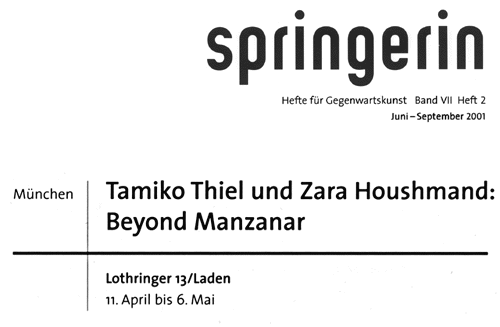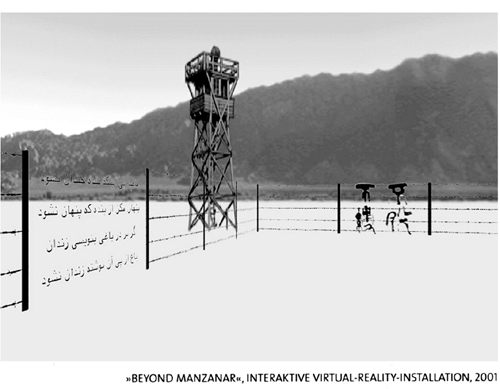<- Back to Articles page
 |
Review by Michael Hauffen in
|
|
In search of the thrilling interactive installations that are unceasingly promised to us, we are often overcome by the feeling that we are ourselves prisoners of virtual scenarios. The much-praised navigational possibilities provided by the joystick are probably most convincing when they ironically or critically reflect on the massive and enthusiastic promotions of the multimedia industry, but of course even that is not satisfying in the long run. Under these conditions it is especially gratifying that the interactive virtual reality installation "Beyond Manzanar" directly links the feeling of virtual "imprisonment" to the memory of imprisonment in a real internment camp, thereby adding a very different dimension to the self-referential circle. Manzanar is the name of one of the places in the USA to which, after the bombing of Pearl Harbor, all individuals and families of Japanese ancestry residing in the western states were compulsorily deported in 1942, because it was deemed necessary in order to protect the country from further attacks. |
|

|
|
|
We are transplanted into this camp with the aid of a life-sized video projection in which we can walk between brown barracks - until stopped by a high barbed wire fence and four guard towers. In the windows of the barracks we see scenes of everyday camp life, where inhabitants not only tried to provide food for themselves by planting vegetable gardens, but also endeavored to demonstrate their American convictions with such activities as playing in Big Bands or by reenacting scenes from American history in costume. We encounter such details however only once we maneuver ourselves into one of the barracks, which in addition to realistic images contain background historic documents. Various layers of history are collaged together, provoking cross-references - like the surreal cross-references of our dreams. The initial impression of gloom in a stark, bare room is further underscored by an acoustic dimension: a babble of voices and fragments of melancholy music are strewn between images of individual internees. Deep in the back, a large group portrait allows us entry into a passageway leading towards further sequences of rooms. Behind documents illustrating the national identity of the presumed "enemies of the state" we enter a spacious salon whose walls are hung with highlights from the previous lives of the internees, photos that prove that Japanese-Americans even then adopted the symbols of an American normality. But they also maintained their Japanese traditions, as shown by a Zen garden that really existed in the Manzanar camp - and is not to be missed in the virtual camp either. The montage of spaces and contents we have experienced thus far points to cracks in the dubious ideal of an homogeneous national identity, and our subsequent experiences enrich this montage with yet more layers and elements. While Tamiko Thiel, whose great-grandmother was interned because of her Japanese ancestry, contributed especially to the reconstruction of the historic reality - which by the way was denied for an unusually long time by the Pentagon - the standpoint of Zara Houshmand, an Iranian-American, reflects on the voices demanding internment of Iranians in the USA during the tensions of the Iranian Hostage Crisis 1979-'80. Documents depicting this threat - which was ultimately not carried out - parallel the documents depicting the actual WWII internment; there are also parallel images showing the adoption of American symbols, such as a portrait of John F. Kennedy (who even today enjoys special popularity among Iranian Americans) framed in "oriental" patterns. As we interact with the piece and its multiple shifts between historical realities and alarmingly real future possibilities, we unexpectedly find ourselves in an Iranian paradise garden. The exits leading out of this vision however do not lead back to the room with images of a fanatical public that sees every ethnic "deviant" as a threat - instead, suddenly, our control of the joystick is broken off and our viewpoint switches abruptly to the perspective of a jetfighter circling above the camp, ready for war. As a closing gesture the virtual violence implied throughout the entire scenario is countered by a poetic text that can be read in English and heard sung in Japanese. But indeed throughout the whole experience the installation successfully weaves the diverse multimedia elements together to provoke associations and irritations analogous to those of poetry. |
|
|
Review by Michael Hauffen (Quick and dirty English translation: Tamiko Thiel) |
|